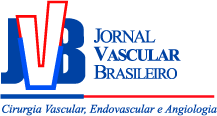Postprandial lipemia and cardiovascular diseases: the beneficial role of strength exercise
Lipemia pós-prandial e doenças cardiovasculares: o papel benéfico dos exercícios de força
Cleiton Silva Correa; Bruno Costa Teixeira; Aline Bittencourt; Rodrigo Cauduro Oliveira Macedo; Álvaro Reischak-Oliveira
Abstract
Keywords
Resumo
Palavras-chave
References
Zilversmit DB. Atherogenesis: a postprandial phenomenon. Circulation. 1979;60(3):473-85.
Zilversmit DB. Atherogenic nature of triglycerides, postprandial lipidemia, and triglyceride-rich remnant lipoproteins. Clin. Chem.. 1995;41(1):153-8.
Zaman GS, Rahman S, Rahman J. Postprandial lipemia in pre- and postmenopausal women. J Nat Sci Biol Med. 2012;3(1):65-70.
Quagliaro L, Piconi L, Assaloni R. Intermittent high glucose enhances ICAM-1, VCAM-1 and E-selectin expression in human umbilical vein endothelial cells in culture: the distinct role of protein kinase C and mitochondrial superoxide production. Atherosclerosis. 2005;183(2):259-67.
Gill JM, Hardman AE. Postprandial lipemia: effects of exercise and restriction of energy intake compared. Am J Clin Nutr. 2000;71(2):465-71.
Petitt DS, Cureton KJ. Effects of prior exercise on postprandial lipemia: a quantitative review. Metabolism. 2003;52(4):418-24.
Tsetsonis NV, Hardman AE. Reduction in postprandial lipemia after walking: influence of exercise intensity. Med Sci Sports Exerc. 1996;28(10):1235-42.
Libardi CA, Souza GV, Gaspari AF. Effects of concurrent training on interleukin-6, tumour necrosis factor-alpha and C-reactive protein in middle-aged men. J Sports Sci. 2011;29(14):1573-81.
Singhal A, Trilk JL, Jenkins NT, Bigelman KA, Cureton KJ. Effect of intensity of resistance exercise on postprandial lipemia. J Appl Physiol. 2009;106(3):823-9.
Parks EJ. Recent findings in the study of postprandial lipemia. Curr Atheroscler Rep. 2001;3(6):462-70.
Shannon KA, Shannon RM, Clore JN, Gennings C, Warren BJ, Potteiger JA. Resistance exercise and postprandial lipemia: the dose effect of differing volumes of acute resistance exercise bouts. Metabolism. 2005;54(6):756-63.
Durstine JL, Grandjean PW, Cox CA, Thompson PD. Lipids, lipoproteins, and exercise. J Cardiopulm Rehabil Prev. 2002;22(6):385-98.
Kolovou GD, Mikhailidis DP, Bilianou H, Panotopoulos G, Nordestgaard BG. Definition of Postprandial Lipaemia. Curr Vasc Pharmacol. 2011;9(3):292-301.
Henry NG. Nonpharmacologic management of low levels of high-density lipoprotein cholesterol. The Am J Cardiol. 2000;86(12):41 5.
Pearson TA, Blair SN, Daniels SR. AHA guidelines for primary prevention of cardiovascular disease and stroke: 2002 Update. Consensus panel guide to comprehensive risk reduction for adult patients without coronary or other atherosclerotic vascular diseases. Circulation. 2002;106(3):388-91.
Blankenberg S, Barbaux S, Tiret L. Adhesion molecules and atherosclerosis. Atherosclerosis. 2003;170(2):191-203.
Patsch JR, Miesenbock G, Hopferwieser T. Relation of triglyceride metabolism and coronary artery disease: studies in the postprandial state. Arterioscler Thromb. 1992;12(11).
Wooten JS, Phillips MD, Mitchell JB. Resistance exercise and lipoproteins in postmenopausal women. Int J Sports Med. 2011;32(1):7-13.
Napoli C, D'Armiento FP, Mancini FP. Fatty streak formation occurs in human fetal aortas and is greatly enhanced by maternal hypercholesterolemia: intimal accumulation of low density lipoprotein and its oxidation precede monocyte recruitment into early atherosclerotic lesions. J Clin Invest. 1997;100(11):2680-90.
Pafili ZK, Bogdanis GC, Tsetsonis NV, Maridaki M. Postprandial lipemia 16 and 40 hours after low-volume eccentric resistance exercise. Med Sci Sports Exerc. 2009;41(2):375-82.
Zafeiridis A, Goloi E, Petridou A, Dipla K, Mougios V, Kellis S. Effects of low- and high-volume resistance exercise on postprandial lipaemia. Br J Nutr. 2007;97(3):471-7.
Goumas G, Tentolouris C, Tousoulis D, Stefanadis C, Toutouzas P. Therapeutic modification of the L-arginine-eNOS pathway in cardiovascular diseases. Atherosclerosis. 2001;154(2):255-67.
Tsetsonis NV, Hardman AE, Mastana SS. Acute effects of exercise on postprandial lipemia: a comparative study in trained and untrained middle-aged women. Am J Clin Nutr. 1997;65(2):525-33.
Petitt DS, Arngrimsson SA, Cureton KJ. Effect of resistance exercise on postprandial lipemia. J Appl Physiol. 2003;94(2):694-700.
LeMura LM, Von Duvillard SP, Andreacci J, Klebez JM, Chelland SA, Russo J. Lipid and lipoprotein profiles, cardiovascular fitness, body composition, and diet during and after resistance, aerobic and combination training in young women. Eur J Appl Physiol. 2000;82(5-6):451-8.
Burns SF, Corrie H, Holder E, Nightingale T, Stensel DJ. A single session of resistance exercise does not reduce postprandial lipaemia. J Sports Sci. 2005;23(3):251-60.
Burns SF, Stensel DJ. Effects of low- and high-volume resistance exercise on postprandial lipaemia. Br J Nutr. 2008;99(1):211.
Paffenbarger RS, Hale WE. Work activity and coronary heart mortality. N Engl J Med. 1975;292(11):545-50.
Tanasescu M, Leitzmann MF, Rimm EB, Willett WC, Stampfer MJ, Hu FB. Exercise type and intensity in relation to coronary heart disease in men. JAMA. 2002;288(16):1994-2000.

